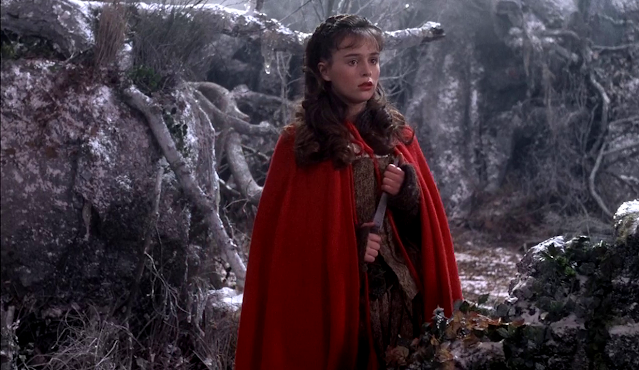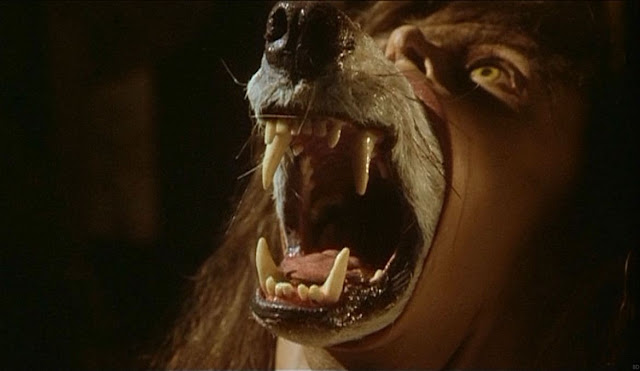The Company of Wolves (1984)
Co-written by Irish filmmaker Neil Jordan and British novelist Angela Carter, and based on several short stories from her collection, The Bloody Chamber, The Company of Wolves is a werewolf film quite unlike any other. A provocative reinterpretation of the fairy tale of Red Riding Hood, it unravels as a feverish exploration of a young girl’s sexuality as she crosses the threshold into adulthood. It was Jordan’s second film, and his first foray into the realms of Gothic horror. Entwining metaphor with striking visuals and grisly effects, The Company of Wolves was released in the early Eighties, in the wake of The Howling and An American Werewolf in London; it set itself apart from the pack, however, with its literary roots, feminist concerns and art-house execution. The folk tales it draws upon and the significance of oral storytelling itself are woven into the very fabric of the film. Its unusual narrative structure, which unfurls like a Chinese puzzle box, begins as a young girl, Rosaleen (Sarah Patterson), falls asleep and begins to dream, and in her dream someone is telling a story, and within that story there are other stories being told. These stories and dreams draw the audience deeper and deeper into the dark woods of the young protagonist’s psyche, as she finds herself on the cusp of adulthood, and further away from any sense of reality. The cautionary stories Rosaleen’s Granny (Angela Lansbury) tells her - of ravening beasts lurking in the forest waiting for young girls to stray from the path, and of men who are ‘hairy on the inside’ - are intended to instil within the girl a fear of being devoured by wolves, and indeed of being devoured sexually, but they only arouse her curiosity and already vivid imagination. Her fascination with sexuality is emphasised by recurrent motifs and symbolism (phallic snakes draped around outstretched tree branches) that speak of sexual temptation, seduction and loss of innocence.
At the heart of many werewolf films is an exploration of the carnal instincts of mankind. The figure of the werewolf is used to explore ideas of transgression, identity and the conflict between human intellect and base instinct; the bestial transformation stripping away civility and notions of order, re-establishing a connection with dormant instincts suppressed through centuries of civilisation. The Company of Wolves is significant because it unblushingly presents its story from the perspective of an adolescent girl and, as such, is a direct precursor to Ginger Snaps (2000), and even the likes of Teeth (2007). Lycanthropy parallels the onset of menstruation and adulthood, speaks of burgeoning sexual appetite, predatory suitors, and provides a barbed commentary on the very real anxieties of growing up female. Carter mined the spirit of the original folk tales - later adapted by the likes of Charles Perrault and the Brothers Grimm - tales in which Red Riding Hood did not depend on a woodcutter to rescue her, but exhibited a wit more cunning than that of the werewolf attempting to seduce and eat her. Throughout their screenplay, Jordan and Carter affirm ‘the beastly side of women, who are shown to be equally capable of being transformed into wolves’ (i) and embracing their sexual instincts. Carter suggested it was not only time for the power of female heroines to be reclaimed, but be ‘brandished’ (ii). In discussing the subject of sexual intercourse with Rosaleen, her mother claims “whatever beast lurks within men, has its match in women, too”; The Company of Wolves acknowledges that primal urges are not exclusive to men, and that women are not just objects of desire, but desiring subjects seeking personal and sexual freedom.
While a provocatively sensual and poetic film, Jordan was still adamant that, as a werewolf film, The Company of Wolves needed to satisfy an audience already primed by An American Werewolf in London and The Howling. With their groundbreaking animatronics and prosthetic effects, these titles reinvented the werewolf film and upped the ante in terms of depicting painfully realised human-to-beast onscreen transformations. Jordan was keen to avoid the human-wolf hybrids favoured by the likes of The Wolf Man (1941) and The Howling, preferring the idea of a person turning into an actual wolf. He maintained that everything that appeared on screen had to be tangible and needed to actually ‘exist in front of the camera’ (iii). He claimed the imagery in films such as Alien (1979) and The Thing (1982) conveyed ‘a very deep hatred of sexuality, a pathological disgust with the human form […] The Company of Wolves was to be about sex, not about hating it’ (iv). As such, he didn’t want his lycanthropic transformations wallowing in anything ‘too repulsive.’ These effects sequences were designed by Christopher Tucker, a former opera singer who created the astonishing make-up effects for David Lynch’s The Elephant Man (1980). He and Jordan decided to depict wolves emerging through the anguished mouths of various characters in order to accentuate the idea of ‘the beast within’. Jordan believed the transformations in Carter’s stories had a sadness and a sensuality about them, as if the heroes couldn’t ‘resist that wolf inside them’, and as if the wolf always longed to be human again (v). His and Carter’s werewolves are seductive monsters imbued with quiet tragedy and pathos, and can be seen as a prelude to the lovelorn vampires in his adaptation of Anne Rice’s Interview with the Vampire (1994).
The Company of Wolves is, sadly, too often overlooked in terms of its place in horror-fantasy cinema, and as a British genre film. This may be due in part to its refusal to be easily categorised. Jordan proudly maintains it ‘doesn’t adhere to any shape or type of film’ (vi). It is a unique beast; part fairy tale, part werewolf film, part horror film, part rite of passage narrative. Perhaps it wasn’t gory enough for horror fans. Perhaps it proved too potent and grotesque for the art-house crowd. Much has been said of its misjudged US marketing campaign, where distribution company Cannon pushed it as a graphic, ‘down and dirty’ horror movie. Now over 30 years old, The Company of Wolves remains, undeniably, a darkly atmospheric, female-centric coming of age fantasy that sits as comfortably alongside the likes of Labyrinth (1986), Lemora (1973), Return to Oz (1985) and Valerie & Her Week of Wonders (1970), as it does Ginger Snaps, An American Werewolf in London and The Howling. It shall forever remain, in the words of Neil Jordan, ‘sensual and brutal, like the fairy tale you dreamed of as a child, but were never told’ (vii).
I was asked to write this piece back in 2017 by an acquaintance who was working on a book about The Howling. He'd planned to include a section within his book focusing on other werewolf films to help provide context. Ultimately, this section was cut from the book, so I have posted it here. If you enjoyed it, and want to read more about The Company of Wolves, check out my book on it.
i Oxford Companion to Fairy Tales, 2000, pg 235
ii http://www.theartsdesk.com/books/angela-carter-inside-bloody-chamber (retrieved 02/03/2016)
iii The Company of Wolves Special Edition DVD Commentary
iv Neil Jordan: Interviews, 2013, pg 43-44
v Neil Jordan: Interviews, 2013, pg 43
vi The Company of Wolves Special Edition DVD Commentary
vii Neil Jordan: Interviews, 2013, pg 41





